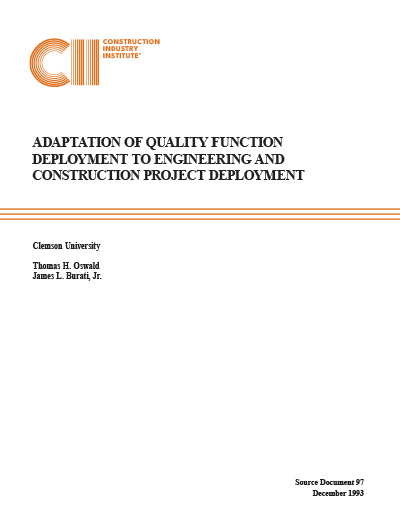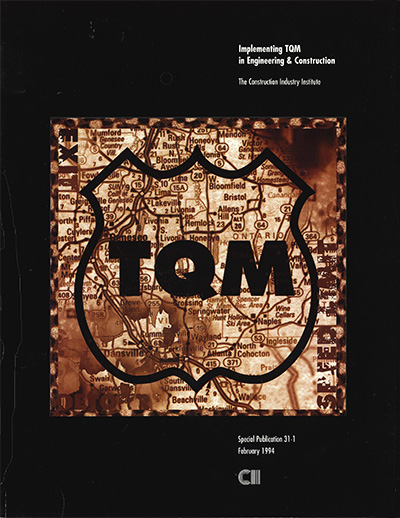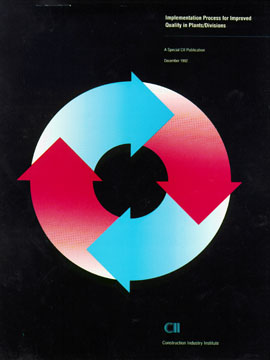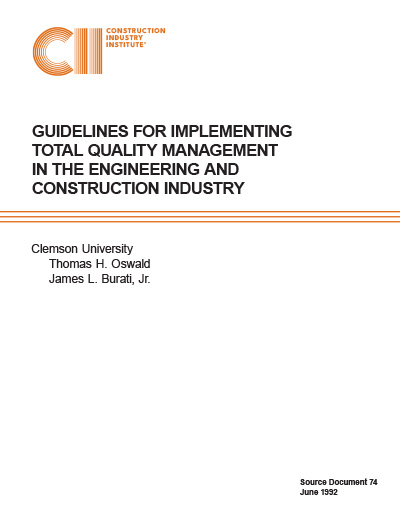
Adaptation of Quality Function Deployment to Engineering and Construction Project Development
Publication No
SD-97
Type
Academic Document
Publication Date
Dec 01, 1993
Pages
168
Research Team
RT-031
DOCUMENT DETAILS
Abstract
Key Findings
Filters & Tags
Abstract
- The current research explores the adaptation of Quality Function Deployment (QFD) to the process of project development in the engineering and construction (E&C) industry. It corroborates the findings of the Phase I QFD Feasibility Study (24), that QFD is a viable and productive technique for enhancing E&C project definition.
- In this document, project development refers to five phases of activity which lead up to the start of construction: the owner’s Business Requirements phase, the Feasibility Study phase, the Conceptual Development phase, the Preliminary Design phase, and the Final Design phase. The additional phases of startup, construction, operation, and disposal are not included. Procurement is not considered a separate phase in this document; rather, it is regarded as an ongoing activity, concurrent with design.
- Specific examples are provided to illustrate the process in the second, third, and fourth of these phases: Feasibility Study, Conceptual Development, and Preliminary Design.
- In the Business Requirements phase, the scope and characteristics of the facility project are rudimentary in nature. QFD would be valuable to the owner in analyzing product and production aspects of the overall business project, but would be of limited value in a facilities sense.
- Nor is QFD application illustrated for the fifth development phase, Final Design. Opportunity exists for using QFD at this stage, but mainly in discrete design situations. Project development, the primary application target of the research, is largely completed by the beginning of the Final Design phase.
- Following the illustration of how QFD can be directly overlaid on the project development process, the report provides an “application framework,” information on how to identify QFD projects, charter and train project teams to use it, and on how the team can then go about using the technique.
- An appendix provides further illustration of the application of QFD to discrete situations, contained within or separate from overall project development.
- Another appendix documents the results of two limited-scope, actual field applications of QFD. The first case has a project management focus, identifying and prioritizing critical activities of the project team to actualize the owner’s business and project objectives for a new-start manufacturing facility. The second demonstration project is design oriented, involving the application of QFD to assist with certain configuration decisions on a system upgrade project.
- QFD is demonstrated to have potential for organizing, completing, focusing, and deploying vital customer requirements information intact throughout the formative phases of project design.
- The paramount importance of first obtaining and organizing basic customer input and then formulating the proper design quality responses, before launching into the matrix operations, is emphasized.
- The research demonstrates QFD’s potential to become a standard tool in E&C project management practice. QFD can be mutually reinforcing in such areas as project cost/schedule controls, materials management, project communications, and others.
- QFD’s value in project definition increases the earlier it is applied in the planning and design process. Ideally, owners might use QFD internally to define broad project parameters before engaging a design firm.
- The farther downstream in the project life cycle that QFD is applied, the lower its potential to add value. Applied at the small system or component level, it is very similar to conventional value engineering.
- A number of opportunities are identified for further QFD research by CII and the E&C industry.
Key Findings
Quality Function Deployment (QFD) – QFD is a method to develop design quality to satisfy customer expectations in the final product by creating alignment with the defined needs of the customer. Key information on implementation of QFD is provided in SD-97 Adaptation of Quality Function Deployment to Engineering and Construction Project Development. (SD-97, p2-1)
- The primary phases that the research team viewed QFD as being most appropriate for implementation include feasibility, conceptual development, and preliminary design. The business requirements phase was considered not to yield opportunities to apply QFD.
- An illustration of the application of QFD to the feasibility stage is provided in SD 97. Similar examples are provided for the conceptual and preliminary design phases. The final design phases offers discrete opportunities for QFD applications but were not illustrated in the document.
Other key information on the QFD process, including the primary definitions of QFD can be found in SD-74.
Filters & Tags
Knowledge Area
Best Practice
Project Phase
Project Function
Industry Group
Research Topic
Total Quality Management
Keywords
QFD,
Quality Function Deployment,
TQM Implementation Roadmap,
TQM Training,
Quality Focus Teams,
Quality Improvement Teams,
rt31



